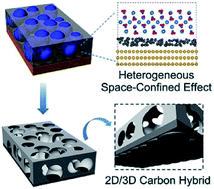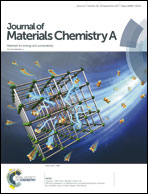Synthesis of 2D/3D carbon hybrids by heterogeneous space-confined effect for electrochemical energy storage†
Abstract
A graphene-reinforced N-doping porous carbon network is fabricated using a simple strategy for the electrodes of supercapacitors and lithium ion batteries. In this approach, sodium carbonate is dissolved with glucose and urea and then the obtained solution is coated on a metal substrate. A subsequent heating process enables the organic complex to convert into N-doping porous carbon network replicating the pattern of the salt template. Moreover, wave-like graphene is formed at the interspace between the metal and salt, which not only increases the overall electronic conductivity but also enhances structural stability for engaging the material with a free-standing feature. The heterogeneous space-confined effect of metal/salt plays a critical role in the formation of this hybrid, which is further investigated by molecular simulation. The various advantages of 2D and 3D structures endow this carbon hybrid with superior electrochemical properties; as a Li-ion battery anode, the hybrid exhibits high reversible capacity (775 mA h g−1 at 0.1 A g−1) and long cycling stability (stability is maintained after 1000 cycles at 2 A g−1); in supercapacitors, it presents high capacitive property (238 F g−1 at 1 A g−1) and, as a result, it exhibits outstanding capacitance retention (118 F g−1 at 200 A g−1).



 Please wait while we load your content...
Please wait while we load your content...